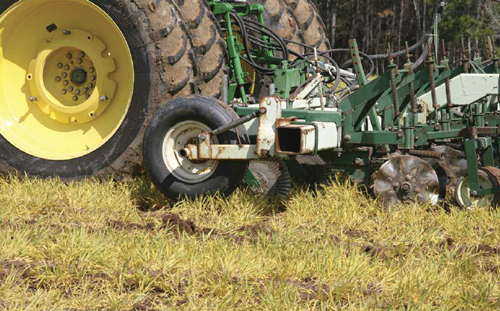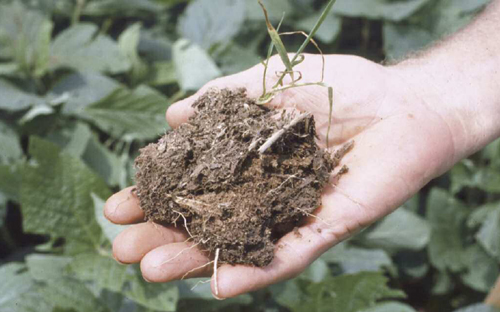Note: this information has been repackaged by NRCS and is available in PDF form here: Aggregate Stability
Aggregate Stability
What it is: Soil aggregates are groups of soil particles that bind to each other more strongly than to adjacent particles. Aggregate stability refers to the ability of soil aggregates to resist disintegration when disruptive forces associated with tillage and water or wind erosion are applied. Wet aggregate stability suggests how well a soil can resist raindrop impact and water erosion, while size distribution of dry aggregates can be used to predict resistance to abrasion and wind erosion.
Why it is important: Changes in aggregate stability may serve as early indicators of recovery or degradation of soils. Aggregate stability is an indicator of organic matter content, biological activity, and nutrient cycling in soil. Generally, the particles in small aggregates (< 0.25 mm) are bound by older and more stable forms of organic matter. Microbial decomposition of fresh organic matter releases products (that are less stable) that bind small aggregates into large aggregates (> 2-5 mm). These large aggregates are more sensitive to management effects on organic matter, serving as a better indicator of changes in soil quality. Greater amounts of stable aggregates suggest better soil quality. When the proportion of large to small aggregates increases, soil quality generally increases.
Stable aggregates can also provide a large range in pore space, including small pores within and large pores between aggregates. Pore space is essential for air and water entry into soil, and for air, water, nutrient, and biota movement within soil. Large pores associated with large, stable aggregates favor high infiltration rates and appropriate aeration for plant growth. Pore space also provides zones of weakness for root growth and penetration. Surface crusts and filled pores occur in weakly aggregated soils. Surface crusts prevent infiltration and promote erosion; filled pores lower water-holding and air-exchange capacity and increase bulk density, diminishing the conditions for root growth.
Specific problems that might be caused by poor function: Aggregate stability is critical for infiltration, root growth, and resistance to water and wind erosion. Unstable aggregates disintegrate during rainstorms. Dispersed soil particles fill surface pores and a hard physical crust can develop when the soil dries. Infiltration is reduced, which can result in increased runoff and water erosion, and reduced water available in the soil for plant growth. A physical crust can also restrict seedling emergence.
Wind normally detaches only loosely held particles on the soil surface, but as blowing soil particles are accelerated by the wind they hit bare soil with sufficient energy to break additional particles loose from weakly aggregated soil. This action increases the number of particles that can be picked up by the wind and abrade a physically-unprotected soil surface.
Practices that lead to poor aggregate stability include:
- Tillage methods and soil disturbance activities that breakdown plant organic matter, prevent
accumulation of soil organic matter, and disrupt existing aggregates, - Cropping, grazing, or other production systems that leave soil bare and expose it to the physical impact of raindrops or wind-blown soil particles,
- Removing sources of organic matter and surface roughness by burning, harvesting or otherwise removing crop residues,
- Using pesticides harmful to beneficial soil microorganisms.
What you can do: You can improve the aggregate stability of your soil by increasing levels of organic matter or applying specialized chemical compounds, such as anionic polyacrylamide (PAM). Practices that keep soil covered physically protect it from erosive forces that disrupt aggregation, while also building organic matter. Any practice that increases soil organic matter, and consequently biological activity, improves aggregate stability. However, it can take several growing seasons or years for significant organic matter gains. In contrast, management activities that disturb soil and leave it bare can result in a rapid decline in soil organic matter, biological activity, and aggregate stability.
Aggregates form readily in soil receiving organic amendments, such as manure. They also form readily where cover and green manure crops and pasture and forage crops are grown, and where residue management and/or reduced tillage methods are used.
Improving aggregate stability on cropland typically involves cover and green manure crops, residue management, sod-based rotations, and decreased tillage and soil disturbance. Aggregate stability declines rapidly in soil planted to a clean-tilled crop.
Pasture and forage plants have dense, fibrous root systems that contribute organic matter and encourage microbial activity. However, grazing and fertility must be managed to maintain stands and prevent development of bare areas or sparse vegetation.
Conservation practices resulting in aggregate stability favorable to soil function include:
- Conservation Crop Rotation
- Cover Crop
- Pest Management
- Prescribed Grazing
- Residue and Tillage Management
- Salinity and Sodic Soil Management
- Surface Roughening
For more information go to Soil Management Practices.

Photo: Conservation tillage systems, such as no-till with cover crops, reduce soil disturbance, and provide and manage residue for increased soil organic matter and improved aggregate stability. Additionally, surface roughness provided by crop residues protects soil from wind erosion.

Photo: Long-term use of a conservation tillage system (no-till) and cover crops resulted in increased soil organic matter and improved soil structure and aggregate stability of this north Georgia (Cecil) soil. Photo courtesy James E. Dean, USDA NRCS (retired).
Measuring aggregate stability:
Measuring Water Stable Aggregates is described in the Soil Quality Test Kit Guide, Section I, Chapter 8, pp. 18 - 19. See Section II, Chapter 7, pp. 69 - 71 for interpretation of results.
Arshad MA, Lowery B, and Grossman B. 1996. Physical Tests for Monitoring Soil Quality. In: Doran JW, Jones AJ, editors. Methods for assessing soil quality. Madison, WI. p 123-41.
Kemper WD, Rosenau RC. 1986. Aggregate Stability and Size Distribution. In: Klute A, editor. Methods of soil analysis. Part 1. Physical and mineralogical methods. Madison, WI. p 425-42.
